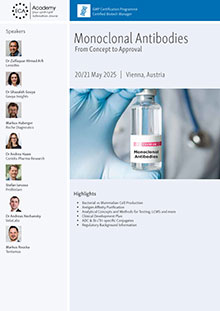QBD IN THE LIGHT OF THE CURRENT PROCESS VALIDATION GUIDANCE
The University of Heidelberg QbD/PAT Conference 2011 was focused on the pivotal role process understanding and process control play in delivering pharmaceutical Quality by Design (QbD) over the lifecycle of a product. To these ends, PAT/QbD performance outcomes have been reviewed in the light of the recently issued Process Validation Guidance. Different aspects of industrial and regulatory opportunities and challenges to achieve continuous verification in API, legacy and biotech manufacturing have been outlined in several workshops and case study lectures. Limitations of batch processing such as changes of critical to quality attributes (CQAs) during scale-up and benefits of continuous manufacture, the critical impact of particle engineering to pharmaceutical process and product performance and the need of creating a versatile, knowledge generating data management platform to facilitate real-time control and support continuous production in secondary manufacture have been discussed in detail.
The key question of "how continuous verification impacts the design space" was raised by Carl Anderson, Duquesne University. In his workshop, the "flexibility that continuous verification brings to the design space" was explored and discussed. The session started with a lively and controversial discussion about the definition of the design space and whether the development of a design space is really a step forward with respect to regulatory flexibility. According to ICH Q8, the design space is defined as the "multidimensional combination and interaction of input variables (e.g. material attributes) and process parameters that have been demonstrated to provide assurance of quality". "Working within the design space is not considered as a change", while working outside the registered design space requires regulatory post approval.
A design space can be developed using process understanding and the knowledge about the functional relationship between material attributes, process parameters and critical quality attributes. It was agreed that the factorial design (i.e. the number of factors and their nominal range) that is used for the development of the design space determines its performance and flexibility to account for unexpected changes and variability. Carl Anderson pointed out that a number of factors such as raw material variability, supply chain disruption, variable storage conditions or equipment wear is usually not considered when creating the design of experiments (DoE) to develop the design space, since it would result in extensive experimental work. If variability of these factors occurs over time, which is often the case, adaptation of the design space is required to meet the product specifications. In this context, Anderson raised the important question "how robust, i.e. dynamic can the design space be made to account for unexpected changes".

Recommendation
27/28 May 2025
How to write the Quality Part of an IMPD - Live Online Training
Based on a model study performed at Duquesne University, the opportunities and challenges of a dynamic design space "accounting for variability, while maintaining product safety and efficacy" were pointed out and discussed. To establish the knowledge space and the design space for the manufacture of Excedrin tablets, a D-optimal Design was used to investigate the effect of various formulation and process parameters, namely the content of croscarmellose sodium, the ratio of microcrystalline cellulose (MCC) to lactose monohydrate and the compression force on the CQAs. Tablets were tested according to USP protocols. Radial tensile strength and disintegration time were identified as CQAs. An optimal set of critical process parameters (CPPs) was chosen to test the robustness of the design space against raw material variability, i.e. the particle size of the API and the ratio of lactose monohydrate to anhydrous lactose. It was found that the impact of raw material variability on the CQAs could be compensated by adapting the CPPs, namely compression force and compression speed. However, optimum values of the CQAs were only obtained with 2 of 3 runs being outside the original design space. This example clearly revealed that "process understanding is the key to pharmaceutical quality", while "continuous verification, i.e. regular review and updates of models is pivotal to its delivery". It was agreed that adaptation of the design space is crucial for process robustness and product performance and should be an integrated part of QbD without regulatory post approval.
Authors:
Dr Gabriele Reich
... a pharmacist with PhD in pharmaceutical technology, is heading the QbD/PAT research group at the Institute of Pharmacy and Molecular Biotechnology (IPMB), Faculty of Biological Sciences, University of Heidelberg.
Carolin-Verena Möltgen
... is a pharmacist and doctoral student in the QbD/PAT research group at the IPMB.
Dr Hendrik Schneide
... a mechanical engineer and PhD in pharmaceutical technology, works as a postdoctoral fellow in the QbD/PAT research group at the IPMB.




